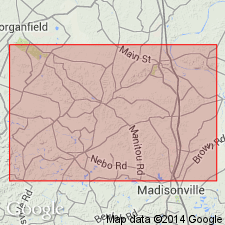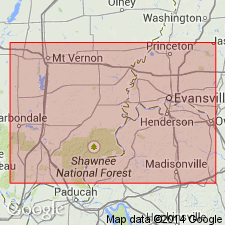
- Usage in publication:
-
- Providence limestone
- Modifications:
-
- Named
- Dominant lithology:
-
- Limestone
- AAPG geologic province:
-
- Illinois basin
Summary:
Providence limestone (new name) described in western KY as blue argillaceous limestone, usually quite impure and variable in composition and irregular in bedding. In places split into two members by a few in. or ft of gray argillaceous shale. Thickness ranges from 0 to 12 ft. Lies 0 to 4 ft above coal No. 11 and lower than coal No. 12. Contains marine fossils. Age is Pennsylvanian.
Source: GNU records (USGS DDS-6; Reston GNULEX).

- Usage in publication:
-
- Providence Limestone Member
- Modifications:
-
- Overview
- AAPG geologic province:
-
- Illinois basin
Summary:
Providence Limestone Member of the Dugger Formation in IN and of the Sturgis Formation in KY and its lithologic correlatives in the southern part of the Illinois basin are described as thin lime mudstones to packstones lying stratigraphically between the Herrin and Hymera Coal Members and their equivalents. Lower part of unit equates with Brereton Limestone Member of the Carbondale Formation in IL. Thickness generally about 6 m in IN. Shallow, nearshore, low- to moderate-energy marine environment reflected by conodont biofacies. Age is middle Desmoinesian.
Source: GNU records (USGS DDS-6; Reston GNULEX).
For more information, please contact Nancy Stamm, Geologic Names Committee Secretary.
Asterisk (*) indicates published by U.S. Geological Survey authors.
"No current usage" (†) implies that a name has been abandoned or has fallen into disuse. Former usage and, if known, replacement name given in parentheses ( ).
Slash (/) indicates name conflicts with nomenclatural guidelines (CSN, 1933; ACSN, 1961, 1970; NACSN, 1983, 2005, 2021). May be explained within brackets ([ ]).

